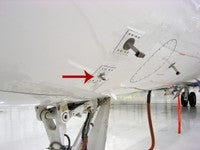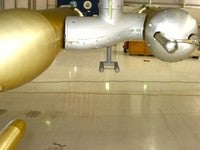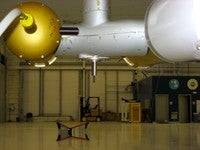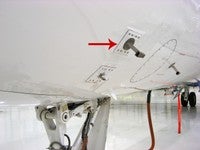Dew Point, Humidity & Water Vapor Instruments
- Dew Point
- PMS Liquid Water Sensor (King)
- Raw Icing-Rate Indicator | RICE
- Total Temperature
- Vertical Cavity Surface Emitting Laser | VCSEL
 This measurement is the corrected dew point with respect to a plane water surface. Below 0C the measured frost point is adjusted to dew point. The difference between the dew point and the frost point is derived from the Goff-Gratch (1946) equations for water vapor pressure over plane surfaces of water and ice. The accuracy of the conversion (one sigma) is 0.02° C over a range of 0C to -80C.
This measurement is the corrected dew point with respect to a plane water surface. Below 0C the measured frost point is adjusted to dew point. The difference between the dew point and the frost point is derived from the Goff-Gratch (1946) equations for water vapor pressure over plane surfaces of water and ice. The accuracy of the conversion (one sigma) is 0.02° C over a range of 0C to -80C.
There are two Dew Point probes, located on both the right and left sides, just below and behind the nose of the aircraft. The Total Temperature probe is just above the Dew Point inlet.
PMS Liquid Water Sensor (King)
 PMS Liquid Water Sensor (King probe) is used primarily for the study of cloud microphysical processes and in icing studies. It uses a heated wire to measure liquid water content (LWC). This instrument is relatively simple and accurate (~ 15%) for higher liquid water content (LWC); however, accuracy is diminished at lower LWC since the baseline (the clear-air signal upon which the in-cloud signal is superimposed) is dependent on airspeed, temperature, and pressure. Droplets between 5- and 40-μm diameter are efficiently sampled. The PMS Liquid Water Sensor resides under the left-wing of the aircraft and sits beween the Two Dimensional Cloud Probe (2D-C) and the Cloud Droplet Probe (CDP).
PMS Liquid Water Sensor (King probe) is used primarily for the study of cloud microphysical processes and in icing studies. It uses a heated wire to measure liquid water content (LWC). This instrument is relatively simple and accurate (~ 15%) for higher liquid water content (LWC); however, accuracy is diminished at lower LWC since the baseline (the clear-air signal upon which the in-cloud signal is superimposed) is dependent on airspeed, temperature, and pressure. Droplets between 5- and 40-μm diameter are efficiently sampled. The PMS Liquid Water Sensor resides under the left-wing of the aircraft and sits beween the Two Dimensional Cloud Probe (2D-C) and the Cloud Droplet Probe (CDP).
Raw Icing-Rate Indicator | RICE
 This is the output from a Rosemount 871F ice-accretion probe. It consists of a rod set in vibration by a piezoelectric crystal. The oscillation frequency of the probe changes with ice loading. When the probe loads to a certain point, the rod is heated to remove the ice. Its output voltage is related to the mass of the accreted ice.
This is the output from a Rosemount 871F ice-accretion probe. It consists of a rod set in vibration by a piezoelectric crystal. The oscillation frequency of the probe changes with ice loading. When the probe loads to a certain point, the rod is heated to remove the ice. Its output voltage is related to the mass of the accreted ice.
The RICE is moiunted beneath the right wing in between the Ultra-High Sensitivity Aerosol Spectrometer (UHSAS) and the Microwave Temperature Profiler (MTP).
 This is the output of the recovery temperature from a calibrated temperature sensor. (For Rosemount temperature probes, the recovery temperature is a close approximation to the total temperature.) In the standard output, the total temperature (and ambient temperature) variable name also conveys the sensor type. The variable named TTx is obtained with a Rosemount Model 102 non-deiced temperature sensor. The variable named TTxH is obtained with a Rosemount Model 102 deiced (heated) temperature sensor.
This is the output of the recovery temperature from a calibrated temperature sensor. (For Rosemount temperature probes, the recovery temperature is a close approximation to the total temperature.) In the standard output, the total temperature (and ambient temperature) variable name also conveys the sensor type. The variable named TTx is obtained with a Rosemount Model 102 non-deiced temperature sensor. The variable named TTxH is obtained with a Rosemount Model 102 deiced (heated) temperature sensor.
There are two Total Temperature probes, located on both the right and left sides, just below and behind the nose of the aircraft. The Dew Point probe is just below the Total Temperature probe.
Vertical Cavity Surface Emitting Laser Hygrometer | VCSEL
 Monitored by : Mark Zondlo
Monitored by : Mark Zondlo
The vertical cavity surface emitting laser (VCSEL) hygrometer measures water vapor concentration throughout the troposphere and lower stratosphere at high frequency (25 times per second), precision (<3%), and accuracy (5-10%). The wide dynamic range of the VCSEL is particularly well-suited for HIPPO Global where environments range from the warm and moist marine boundary layer in the tropics to the cold and dry stratosphere in polar regions. 
In addition, the VCSEL probes atmospheric moisture in an open-path configuration exterior to the aircraft (see picture at left). The lack of an inlet or tubing (which can create sampling artifacts for a "sticky" gas like water vapor) allows for the identification of highly resolved atmospheric layers in the horizontal and vertical. The heart of the instrument is a fiberized laser that passes near infrared light between two gold-coated mirrors that form the optical measurement cell.